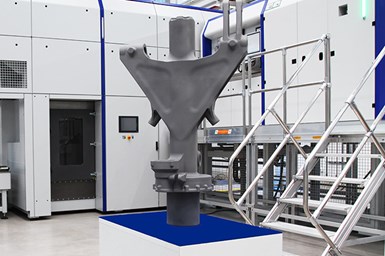Safran, SLM Solutions Test Technology for Large Airplane Component
In a joint project, Safran Landing Systems and SLM Solutions tested selective laser melting to produce a component of a nose landing gear for a bizjet, marking a world first for a part of this size.

Selective laser melting (SLM) was used to produce this main component of a bizjet nose landing gear, marking a world first for a part of this size.
Safran Landing Systems and SLM Solutions recently collaborated on testing selective laser melting (SLM) to produce a main component of a bizjet nose landing gear, marking a world first for a part of this size.
The joint objective of the project was to demonstrate the feasibility of producing a main fitting using the SLM process. The component was redesigned for metal-based additive manufacturing (AM), which enabled valuable time-savings in the whole process as well as a significant weight reduction of approximately 15% of the component.
This component is one of the parts that transfers the loads from the wheel to the aircraft structure and is retracted after take-off, which necessitates stringent requirements for its construction. Safran selected titanium alloy for the testing process, as it is a material with high mechanical properties, is naturally resistant to corrosion and does not require any surface treatment. The alloy also helps increase part durability.
With a vertically extended build envelope, the SLM800 is said to be well adapted to produce large components. The machine is equipped with SLM Solutions’ quad-laser technology and innovative features, such as the patented gas flow and a permanent filter, that ensure highest reliability, the company says.
One of the strengths of the SLM technology is its flexibility. Design changes can be quickly modified, printed and tested, meaning less time is spent during prototype development. The part measured 455×295×805 mm and featured a new design, which met ambitious resistance and mass reduction objectives.
“Additive manufacturing contributes to save time in the qualification and certification phases by rapidly providing the parts for testing,” says Gerhard Bierleutgeb, EVP global services and solutions at SLM Solutions. “We were able to produce the main fitting in few days on the SLM800 versus a few months with the forging process.”
Related Content
-
Video: For 3D Printed Aircraft Structure, Machining Aids Fatigue Strength
Machining is a valuable complement to directed energy deposition, says Big Metal Additive. Topology-optimized aircraft parts illustrate the improvement in part performance from machining as the part is being built.
-
How Norsk Titanium Is Scaling Up AM Production — and Employment — in New York State
New opportunities for part production via the company’s forging-like additive process are coming from the aerospace industry as well as a different sector, the semiconductor industry.
-
Video: AM for Repair of Large Shafts
Wind power shafts that might once have been scrapped are now returned to service. See the robotic directed energy deposition (DED) and shaft preheating system developed by Ikergune, Izadi and Talens.













